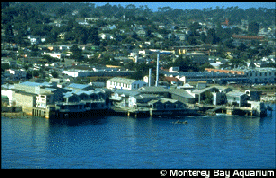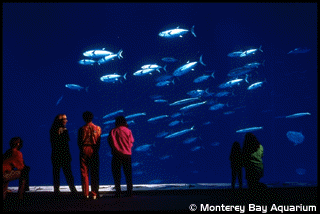May 17, 1996
Just down the street from the dusty lab where Ed “Doc” Ricketts used to collect marine animals in jars stands the slick Monterey Bay Aquarium. Ricketts, the colorful marine biologist and ladies’ man made famous in Steinbeck’s “Cannery Row,” was the first to study the rich variety of sea life along Monterey’s rocky shore. Now, a new world that Ricketts saw only in his imagination has opened. On March 2, the Monterey Bay Aquarium opened its new wing, a display of mysterious life forms that live in Monterey’s Outer Bay.
 Monterey Bay is part of the world’s largest protected marine sanctuary and is rich in diverse marine life. The bay is home to sea otters, sea lions, orcas, gray whales, blue whales, elephant seals, great white sharks, and unimaginable numbers of fish, sea animal and plant species. Before its expansion, the museum displayed plant and animal habitats along Monterey’s intricate shoreline and in the thick kelp forest of the inner bay. The new wing displays life in the open expanses of the Outer Bay.
Monterey Bay is part of the world’s largest protected marine sanctuary and is rich in diverse marine life. The bay is home to sea otters, sea lions, orcas, gray whales, blue whales, elephant seals, great white sharks, and unimaginable numbers of fish, sea animal and plant species. Before its expansion, the museum displayed plant and animal habitats along Monterey’s intricate shoreline and in the thick kelp forest of the inner bay. The new wing displays life in the open expanses of the Outer Bay.
The Outer Bay experience begins with a display of anchovies circling like a silvery halo above visitors’ heads. The 3,000 shiny fish swim endlessly in a doughnut-shaped tank set high in the wall of the first room. The constant circular motion, along with eerie New Age music and soft lighting, made me a bit dizzy. The anchovies swam round and round, all traveling in the same direction, and I wondered if they ever stopped, ever rested, or if they spent their whole lives chasing the tail of the fish before them. Then, I noticed one lone anchovy, fearlessly swimming against the flow, battling his way head on into the onslaught of his peers.
The haunting music lured me further in as I fell into a trance, disrupted only by an occasional screaming child or loudspeaker announcement. The next room highlighted the Outer Bay’s “drifters,” including eight different kinds of jellyfish. From the backlighted tanks the jellies appear ghost-like as their glowing, bodies gracefully swayed back and forth with the simulated currents. It seemed like hours that I stood mesmerized by the dancing jellies. I was particularly taken by the translucent white-moon jellies. Their beauty was indeed unearthly.
The grand centerpiece of the Outer Bay display is a huge million-gallon, 35-foot-tall tank featuring “the swimmers.” Visitors peer through at the variety of fish and a sea turtle through the largest window in the world, an acrylic panel 14.5 feet high, 54 feet long, weighing 78,000 pounds. The exhibit is home to California barracuda, ocean sunfish, Pacific bonita, a small soupfin shark, and a sea turtle. A balcony with seating is provided to better study the expansive exhibit. Curiously, ropes hung down vertically along the inside of the window. “That’s for the sunfish,” an aquarium volunteer informed me. “They keep running into the window.”
 The tank previously contained two highly publicized blue sharks that died before the new wing opened. The first shark apparently developed an infection from rubbing against tiles in the tank. The second died from a problem with its digestive system. Sharks are very difficult to keep in captivity as they do not understand their boundaries within the tank, and often ram against the glass sides or floor of the tank. “It’s such and open ocean animal,” Joe Choromanski, curator of husbandry operation for the aquarium, told the Monterey County Herald. “People have tried to keep them in captivity with only limited success.”
The tank previously contained two highly publicized blue sharks that died before the new wing opened. The first shark apparently developed an infection from rubbing against tiles in the tank. The second died from a problem with its digestive system. Sharks are very difficult to keep in captivity as they do not understand their boundaries within the tank, and often ram against the glass sides or floor of the tank. “It’s such and open ocean animal,” Joe Choromanski, curator of husbandry operation for the aquarium, told the Monterey County Herald. “People have tried to keep them in captivity with only limited success.”
Nevertheless, the Monterey Bay Aquarium is an impressive institution. Part of historic Cannery Row and housed by an old cannery, the aquarium is a must-see for all visitors to Monterey. Non-profit and totally privately funded, it was opened in 1984 by electronics mogul David Packard and $55 million of his money. His daughter Julie Packard is executive director. The addition of the Outer Bay wing was an aggressive step in expanding the aquarium’s dedication to public education.
The aquarium’s goal is to “stimulate interest, increase knowledge and promote stewardship of Monterey Bay and the world’s ocean environment through innovative exhibits, public education and scientific research.” From jars of formaldehyde to million-gallon tanks, Doc Rickett’s spirit lives on, down the street and light years away.
Laurel Chesky
Photos courtesy of Monterey Bay Aquarium